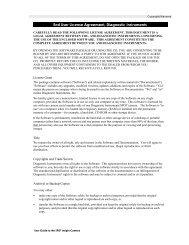optical interference filters - SPOT Imaging Solutions
optical interference filters - SPOT Imaging Solutions
optical interference filters - SPOT Imaging Solutions
Create successful ePaper yourself
Turn your PDF publications into a flip-book with our unique Google optimized e-Paper software.
Filter design<br />
All boundaries between media are divided into reflected and transmitted portions of the electromagnetic<br />
wave. Those portions of the wave not reflected are transmitted across the boundary to a new medium with dissimilar <strong>optical</strong><br />
properties. These differences cause refraction, or a change in the speed and angle of the wave. A material’s refractive index is<br />
defined as the ratio of the velocity of light in a vacuum to the velocity of light in that medium. The amount of light reflected is<br />
related to the difference between the refractive indices of the media on either side of the boundary; greater differences create<br />
greater reflectivity. For non-absorbing media, if there is an increase in refractive index across the boundary, the reflected wave<br />
undergoes a phase change of 180º. If there is a decrease no phase change would occur. An <strong>optical</strong> thin-film coating is a stack<br />
of such boundaries, each producing reflected and transmitted components that are subsequently reflected and transmitted<br />
at other boundaries. If each of these boundaries is located at a precise distance from the other, the reflected and transmitted<br />
components are enhanced by <strong>interference</strong>.<br />
Unlike “solid” particles, two or more electromagnetic waves can<br />
occupy the same space. When occupying the same space, they interfere<br />
with each other in a manner determined by their difference<br />
in phase and amplitude. Consider what happens when two waves<br />
of equal wavelength interfere: when two such waves are exactly out<br />
of phase with each other, by 180°, they interfere destructively. If<br />
their amplitudes are equal, they cancel each other by producing a<br />
wave of zero amplitude. When two such waves are exactly in phase<br />
with each other, they interfere constructively, producing a wave of<br />
amplitude equal to the sum of the two constituent waves.<br />
An <strong>optical</strong> thin-film coating is designed so that the distances<br />
between the boundaries will control the phase differences of the<br />
multiple reflected and transmitted components.<br />
c) The polarization effects at non-normal angles of incidence.<br />
These characteristics are influenced by the number of boundaries,<br />
the difference in refractive index across each boundary and<br />
the various distances between the boundaries within a coating.<br />
When light does not strike an <strong>interference</strong> filter at normal (normal<br />
is orthogonal to the plane of the filter), the situation becomes a bit<br />
more complicated. We now must consider the transmission and<br />
reflection of light depending on the orientation of the electric field<br />
to the plane of incidence. This orientation of the light’s electric field<br />
to the plane of incidence is called the polarization of the light. The<br />
polarization of incident light can be separated into two perpendicular<br />
components called “s” and “p”. For a complete treatment of<br />
the behavior of light of different polarization, we recommend the<br />
classic textbook “Optics” by Eugene Hecht. For now, we’ll present<br />
Fresnel equations that describe the behavior of the two polarizations<br />
of light when they interact with a surface.<br />
The diagram below shows the relevant rays to our discussion. We’ll<br />
keep the notation used in the diagram for the Fresnel equations<br />
below: θ i<br />
is the angle of incidence, θ r<br />
is the angle of reflection and<br />
θ t<br />
is the refracted angle of transmission.<br />
Source: Thin Film Optical Filters by Angus Macleod<br />
When this “stack of boundaries” is placed in a light path, constructive<br />
<strong>interference</strong> is induced at some selected wavelengths, while<br />
destructive <strong>interference</strong> is induced at others.<br />
With the aid of thin-film design software, we apply <strong>optical</strong> thin-film<br />
theory to optimize various coating performance characteristics<br />
such as:<br />
a) The degree of transmission and reflection<br />
b) The size of the spectral range over which transmission, reflection<br />
and the transition between them occur<br />
First, we can use Snell’s Law to determine θ t<br />
from θ i<br />
:<br />
To find the amount of transmitted and reflected light, we use the<br />
Fresnel equations:<br />
For current product listings, specifications, and pricing:<br />
www.omega<strong>filters</strong>.com • sales@omega<strong>filters</strong>.com<br />
1.866.488.1064 (toll free within USA only) • +1.802.254.2690 (outside USA)<br />
21

















